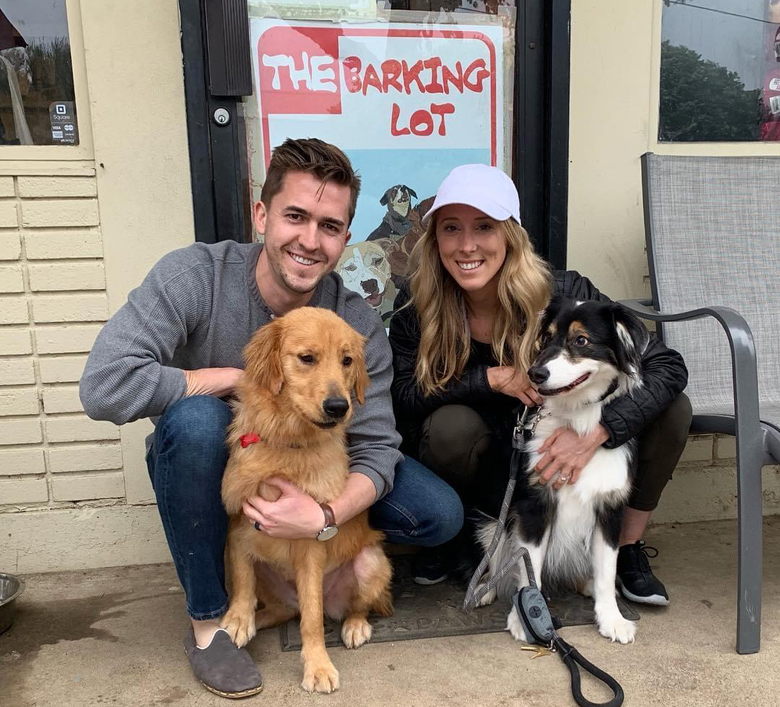Garron Engstrom: A Helping Hand Through Design
A chat about product design and building inclusive teams.
A Redirection

Garron Engstrom admits he doesn’t have a grand story about getting involved with product design. He wasn’t handed a computer at the age of five and felt an immediate connection. Actually, Engstrom attended UC San Diego to study Cognitive Science and was interested in the neuroscience path. But after working in a lab to conduct research, he realized the job he thought he wanted to pursue for so long may need some updating.
“I definitely had this crisis mode when I was going into my senior year, and I realized I didn't want to do what I was doing.”
As a result, he decided to pursue the same degree, but with an alternate focus on Human-Computer Interaction. By speaking to alumni who studied Human-Computer Interaction, Engstrom found that most of these alumni had ended up working with product design or user experience design. He started off in interaction design, but eventually found himself doing product design.

“Over my career, I've just really tried to identify gaps in the skillset. And I think that eventually led me to like product design.”
Engstrom took classes and began to recognize the needs in the design industry. Now, he works as a Product Design Manager in the Social Impact team at Facebook.
All in a Day’s Work
While working at Facebook for the past four and a half years, he was an Individual Contributor (IC) designer and was recently promoted to management. With his new position, while he still designs, his main focus is managing co-workers and product strategy. Engstrom’s role is full of working with designers that report to him and an array of other people, like researchers and data scientists. Together, they work on developing product strategies.
Engstrom works on the Social Impact team where he has worked on products like AMBER Alerts, Crisis Response and a new product called Community Help. In addition, he supports Voter Empowerment, especially with the upcoming 2020 Presidential Election.

Although designers wouldn’t usually find this surprising, Engstrom doesn’t spend a lot of time with headphones on, designing at his desk. A big part of his job is collaborating with other teams. He needs to make sure that he’s aware of the goals of other teams while also solidifying how those align with his goals. Even the simplest product takes a lot of “cross-functional collaboration”.
“Sitting down and designing is sort of the easy part. It's the rest of it that’s hard and time-consuming,” he said.
Before the pandemic, Engstrom’s days were always on the move between collaboration and communication among other team members. Circumstances were business as usual, with everyone focusing on their respective product spaces. When the World Health Organization declared Coronavirus a global pandemic, a group of employees got together among the Social Impact and Health teams.
Engstrom was prepared for some of the aspects the pandemic brought up, like cutting his own hair. He’s actually been cutting his hair for the past 15 years, which has allowed cutting even the back to be muscle memory by this point. But bigger stylistic challenges arose during this time.

“We sort of said, what can we do? How can Facebook respond to this? And at the time, there was a lot of misinformation on the platform.”
Engstrom and this group wanted to play an active role in combating the consequences of the pandemic. As a result, they built and globally launched the Coronavirus Information Center on Facebook. This was a center of information from the World Health Organization and the CDC that users could access. Within Crisis Response, there was also a feature called Community Help, used to mark yourself safe during a crisis so your friends and family know you’re okay. This also allows people to request and assist each other in various situations.
“[Coronavirus is] something that just broadly and generally affects everyone,” he said. “That was definitely an all-hands-on-deck.”
Representation through Product Design
When Engstrom was 30 years old, he realized he felt a little stuck in his career while working at Facebook. Although he loved designing, he wanted to have an impact through the work he was passionate about. He found that being a part of the Social Impact team would give him the opportunity to work on hard societal problems and make genuine change through design. He often asks himself, “How does that translate to the real world?” That impact is his favorite part of his job, which made working at the Social Impact team the shift in direction he needed.
But Engstrom is also aware that the tech industry doesn’t present the same opportunities to everyone.

“There's not enough diversity. Underrepresented people in tech, in general, is an issue,” said Engstrom.
Facebook is putting in a lot of effort to make the company more inclusive. According to Engstrom, Facebook has a goal to make sure 50 percent of their workforce is made up of underrepresented groups by 2024. And by 2025, Facebook intends to “increase Black representation in leadership by 30 percent”.
Engstrom sees that keeping in mind accessibility is an important aspect. When designing, he has to make sure differently-abled people can use their products. Facebook also has additional teams that consult with product teams to ensure they’re building products inclusively.
“At Facebook, we're in a very unique position to not have a core user demographic, our user demographic is the whole world. And if we want to build a product for everyone, we need to make sure that we internally represent that demographic,” Engstrom said.
He talked about studies that show how difficult it is to recruit and retain underrepresented demographics to teams if there aren’t already underrepresented people on the teams. Thus, there’s a cycle of exclusivity.

“I think when you're building a team from scratch, that's something you have to really build in from the beginning,” he said. “As a white male, leading product teams, I'm very cognizant of the makeup of my teams.”
Being on the Social Impact team, it’s especially important Engstrom makes sure that products are representative of those who use them. He intentionally moved to this team to use his skills as a designer to have a positive influence on social issues. He’s focused on helping communities support one another through tough circumstances, like with Crisis responses and AMBER Alerts.
“I see my role, now as a manager, in making sure that our product teams are diverse and can represent all of our user base.”
Engstrom also noted how there is a product called Lift Black Voices, which serves to support Black-owned businesses and racial justice causes. This product allows people to immerse themselves and better understand how to help Black lives.
To make sure a product is impacting multiple demographics and will be inclusive, designers often seek out varying opinions and perspectives.
But in an ideal circumstance, Engstrom believes there wouldn’t be a need to search for those voices, as they would be “naturally built-in and ingrained in the culture, the teams and in the products”. When it comes to diversity in tech, it’s about naturality. Having those diverse voices already in the industry matters, which would allow designers to build inclusive products in a natural way.
Focus on the Intention

Engstrom sees “continuous improvement and learning” as a powerful way for new designers to build upon skills. This approach helped him in his career, which encouraged him to be self-aware and identify any skill areas he should improve upon. He also focuses on intention. In order to better himself, he found that intentionally learning and practicing was a process that brought him to where he is now.
Design isn’t always about making things look nice, according to Engstrom. It’s about understanding the underlying problem and approaching it with the solution supported by thought-out decision making and rationale.

“Less design is more. There's a lot typically below the surface to any given product that's designed.”
At the end of the day, Engstrom hopes to make an impact through his work. From stumbling into his career as a young adult in college to becoming a Product Design Manager for Facebook, Engstrom followed his passion with determination and intention.
“For me, design is the vehicle to have social impact. It's a skill set that I've built up over time and now I can aim it and focus it on trying to have some sort of real-world impact and to improve lives.”
You can find Garron Engstrom’s work here.
The information provided herein is for general informational purposes only and is not intended to provide tax, legal, or investment advice and should not be construed as an offer to sell, a solicitation of an offer to buy, or a recommendation of any security by Candor, its employees and affiliates, or any third-party. Any expressions of opinion or assumptions are for illustrative purposes only and are subject to change without notice. Past performance is not a guarantee of future results and the opinions presented herein should not be viewed as an indicator of future performance. Investing in securities involves risk. Loss of principal is possible.
Third-party data has been obtained from sources we believe to be reliable; however, its accuracy, completeness, or reliability cannot be guaranteed. Candor does not receive compensation to promote or discuss any particular Company; however, Candor, its employees and affiliates, and/or its clients may hold positions in securities of the Companies discussed.
